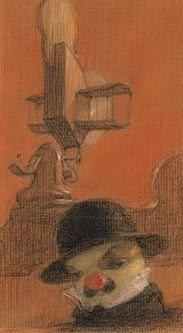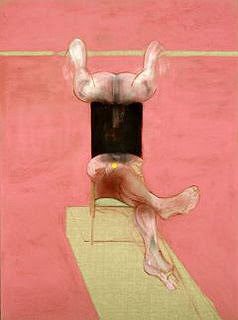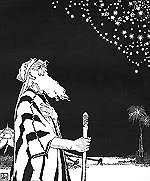
Hay en la obra de Carlos Nine nostalgia por el pasado. Se trata de un pasado ya remoto. Pasado hoy descompuesto. Pero pasado no pisado. Nine nos lleva a reencontrarnos con él a través de la melancolía que emana de su obra. Es el tiempo en que nuestros predecesores eran aún jóvenes. Omnipresente, lo Imaginario se manifiesta en la obra Nine rodeado por una atmósfera que evoca con persistencia al mundo de nuestros abuelos, bisabuelos, tatarabuelos.
El territorio cronológico sobre el que Nine despliega sus alas gráficas comienza preferentemente en el último cuarto del siglo XIX, el post-impresionista, el del esteticismo y la decadencia, el del simbolismo y algo más. Ese período abarca unos sesenta o setenta años y llega hasta alrededor de mediados del siglo XX. Dicho lapso no sólo inspira a Carlos Nine sino que además incluye todo lo que resulta decisivo para el desarrollo del arte moderno en general y para la República Argentina en particular, jugando esta última su doble rol de tierra de promisión y granero del mundo.
En su quehacer, Nine tiende a reconstruir aquellos años y con la ayuda de su muy personal imaginería logra establecer una especie de vínculo transatlántico que reconecta Europa con América, casi como allá lejos y hace tiempo.
Nine ilustra aquella Belle Époque, la que fue, pero que ya no es.
A eso Nine lo tiene claro.
Ya por necesidad, ya por evasión, ya porque se le den las mismísimas ganas, lo cierto es que en ese período Nine se mueve a sus anchas.
Carlos Nine es un artista perceptivo y está bien informado acerca de la historia del arte, la que en su caso personal incluye además los adelantos tecnológicos y otros asuntos propios del período al que su obra nos remite.
A los referentes que nutren su imaginería, Nine los absorbió y los destiló para luego transformarlos hasta el punto de volverlos casi irreconocibles. Celoso de lo suyo e iconográficamente orgulloso, Nine se empeña por evitar la cita literal.



Parece él conocer como la palma de su mano al aporte de los visionarios románticos, la opalescente imaginería simbolista, el efecto Lautréamont y la bellezas convulsivas formuladas por el surrealismo. De un modo más o menos implícito, Goya, Redon y Ernst coexisten en sus trabajos sin que ello excluya ni eclipse la presencia de Archimboldo, John Tenniel y/o Walt Disney.
Con todo, la obra gráfica de Carlos Nine es enfáticamente original. Siempre admirable por su brillantez técnica. A veces controversial por su contenido.


Es el arte de la ilustración el que lleva a Nine a tenérselas que ver con ogros, hadas y otros seres imaginarios. Algunos de sus personajes para los cuentos de infantes son sofisticados, otros resultan cuestionables debido a su aspecto siniestro. Perturbador resulta el uso que Nine hace de la deformación y de lo híbrido, ingredientes que a veces combina en una sola de sus figuras.

Paradójicamente, es en su producción gráfica para adultos donde Nine se deleita con los juguetes de antaño, con los caballitos de madera, los muñequitos a cuerda, las cajas-sorpresa, los autitos de lata y el eterno misterio que cubren los disfraces. Un mundo de juguete rodea a sus personajes. Es el mundo del trencito que corre por el prado y el autito que transita por la aldea grande. Ambos observados por un ojo clínico.


Tal vez las ilustraciones que Nine hace para los cuentos de niños sean una concesión, ya que la esencia de su arte se halla en aquello que produce para el público adulto. En efecto, es allí donde sobresale su vigor expresivo. En el Lago de los cisnes no.
Si bien personalísima, la obra de Nine no es para nada moderna sino una especie de modernismo con fobia de volverse avant-garde. Indudablemente Nine no es El Lissitzky. Debido a ello, en el arte de Nine pueden detectarse ideas tradicionales. La actitud de Nine respecto a ellas es ambivalente: las afirma y simultáneamente se burla de ellas. Respecto al quehacer sexual, por ejemplo, Nine se halla aparentemente más cerca de la filosofía de Schopenhauer que de la sociología de Durkheim, del ángulo de Edgar Degas que del punto de vista de Aubrey Beardsley, del tango Cambalache que del Sueño de una noche de verano articulado por Mahler.


Dicho en otros términos, la obra de Carlos Nine tiene mucho más que ver con el Matadero de Esteban Echeverría que con El beso de Gustav Klimt.
Seducción, copulación y homicidio son asuntos que atraen a Nine, mucho.


Desconcertante, el prejuicio figura en el trabajo gráfico de Nine. Hay en él juegos de palabras, doblesentidos, abuso verbal. No falta la prepotencia ni escasean las alusiones al autoritarismo. Hay sabor a maltrato y crujir de violación.


Nine se ocupa del extraño-inquietante que alguna vez fue formulado por Friedrich von Schelling como "aquello que debía haber quedado oculto, pero que no obstante se ha manifestado."[1]
El increíble efecto que la obra de Nine produce puede llegar a ser comprendido gracias a Freud:
"El efecto ominoso de aquello que resulta extraño y desconcierta tiene lugar cuando los límites entre fantasía y realidad se hacen difusos, cuando algo que era entendido en términos imaginarios se manifiesta como real."[2]
Asunto de doble filo es entonces el arte de Carlos Nine. Asunto desinhibidamente problemático, ya que entremezcla además la belleza con el asco.


Nine ataca por sorpresa y revela aquello que permanecía oculto y reprimido. Nos muestra entonces la otra cara de lo familiar. Nos enrostra lo Siniestro.
Para ello, Nine configura imágenes que son autocontradictorias, figuras y situaciones insólitas en las que lo familiar y lo extraño se conjugan al unísono. Así, Nine nos confronta con lo familiar vuelto inquietante.[3]


Podría tal vez pensarse que la obra de Nine es inclasificable, pero tal idea resulta inadecuada en su caso. Ya que categórico amo y señor de las deformadas bellezas de Nine es ante todo—y por sobre todo—lo Grotesco.


Exageración, incongruencia y deformidad son características distintivas del género grotesco. Es posible definir lo Grotesco como una estructura que involucra tensión y se basa en la mezcla elementos incompatibles, para sugerir entonces algo monstruoso.[4]

En sus Epístolas, Horacio se refiere a cierta "armonía discordante."[5] Tal condición, problemática, es la que se da en el arte de Nine dado su empleo recurrente del grotesco pictórico. Es por ello que tal arte exhibe seres incongruentes o paradójicos, los que suelen ir acompañados de expresiones verbales raras o desproporcionadas. En su hábil manejo de lo Imaginario, Nine construye figuras que son grotescos por derecho propio. Son adorables engendros formulados a partir de estrategias de combinación, mezcla y deformación. Precisamente el modus operandi y los frutos del mismo ligan a Carlos Nine con el linaje de El Bosco, J.J. Grandville y Alfred Kubin.

De nuestra observación y análisis de la obra de Carlos Nine emerge que en ella fermentan importantes elementos del grotesco pictórico: tensión, ambigüedad, exageración, ridiculez, radicalidad. Tan fuerte es la predilección de Nine por lo Grotesco, que en su obra tiene lugar la cruza de especies que la Naturaleza mantenido desde siempre divorciadas.


Desde un punto de vista estructural, las cópulas gráficas de Nine dan lugar a monstruos, híbridos, bestias humanas.

Tal situación puede vincularse con la inscripción del Capricho Nº 43 de Goya: "El sueño de la razón produce monstruos."[6] A través de su grabado, el maestro español sugiere que la lógica unida a la fantasía es madre de las artes y de sus maravillas. Análogo es lo ocurre con Nine. En efecto, se trata del gran Saturno de la gráfica argentina: sorprendente, impactante y siempre vigente debido a su talentoso manejo de lo Grotesco.
..................................................................Mariano Akerman
Notas
1. Al manifestarse lo extraño-inquietante, lo familiar cede terreno a la angustia. Pilar Errázuriz nota que lo paradójico de tal fenómeno consiste en que la fuente de perturbación no es lo extraño en su oposición a lo familiar, sino que lo que antes era familiar de golpe se ha tornado amenazante y peligroso, poniendo en evidencia algo que hasta entonces se había mantenido oculto, en la sombra (El rostro siniestro de lo familiar, Ciber Humanitatis, No. 19, Universidad de Chile, 2001; consultado 13.3.2009).
2. Sigmund Freud, "Lo Ominoso" (Das Unheimliche), 1919. Acerca de su contenido y estructura, ver Anne Clancier, Psicoanálisis, Literatura, Crítica, Madrid: Cátedra, 1973, pp. 48-49; también "Unheimliches nach Sigmund Freud", recop. Justo Fernández López, Hispanoteca, Universität Innsbruck, 1999.
3. Mariano Akerman, Lo familiar vuelto inquietante, Imaginarium, 13.3.2009
4. La definición formulada resulta de considerar los estudios de George Santayana, Wolfgang Kayser y Philip Thomson. Para un debate acerca de la misma, ver Mariano Akerman, The Grotesque in Francis Bacon’s Paintings, tesis, 1999, pp. 16-19.
5. Horacio, Epístolas, libro 1, No. 12, l. 19. Para una discusión, ver ídem, pp. 19-23; también El mismo orden, Asterisk, 6.2.2007
6. Francisco de Goya y Lucientes, Capricho Nº 43, 1799, aguafuerte, aguatinta y punta seca, Calcografía Nacional, Madrid. El texto que acompaña al boceto preliminar (1797) de su grabado reza: "El autor, soñando. Su yntento solo es desterrar bulgaridades perjudiciales, y perpetuar con esta obra de caprichos el testimonio sólido de la verdad."
Referencias: Sitio oficial de Carlos Nine • Declaración y cronobibliografía























